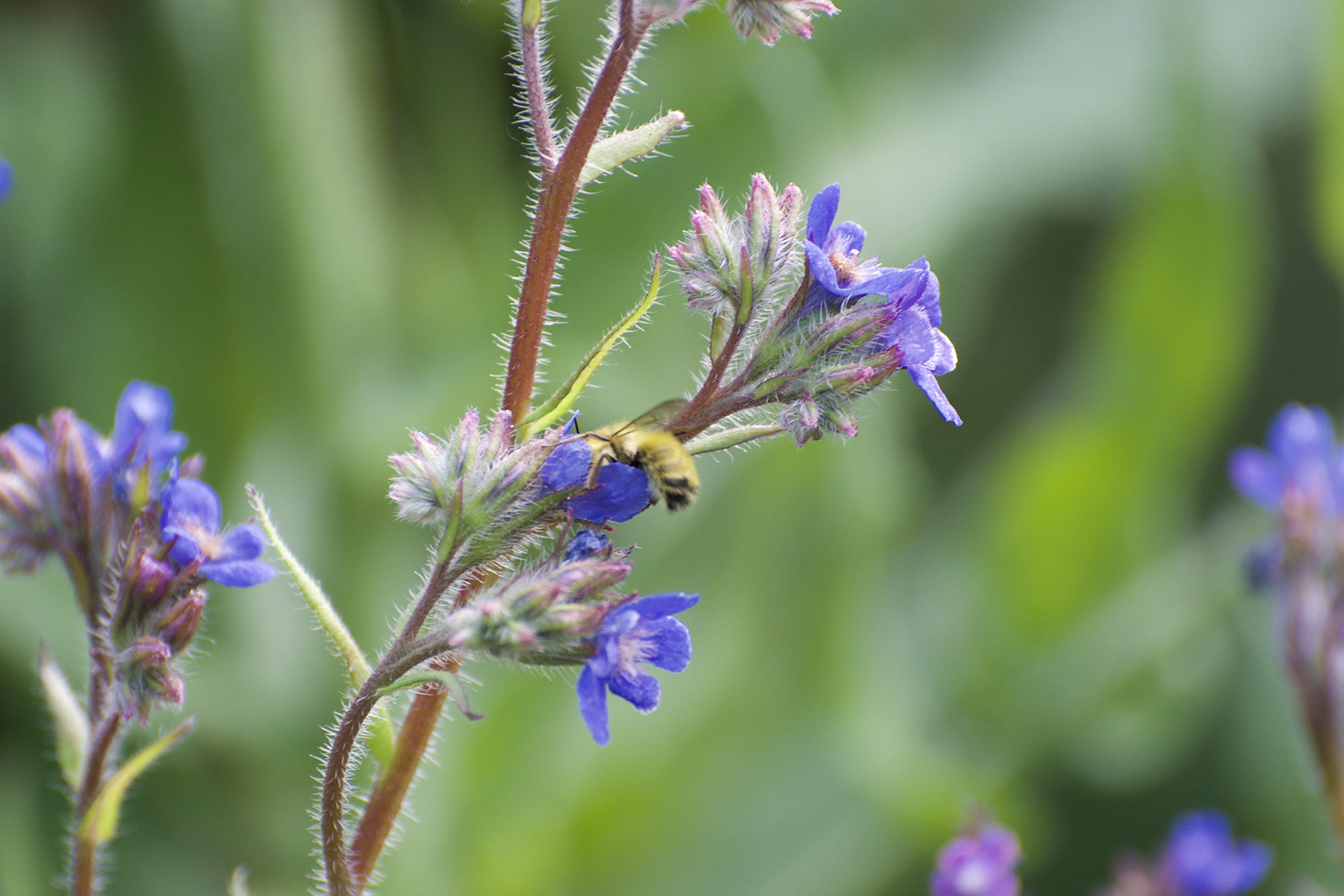Yesterday I wrote about Hemlock, a poisonous plant that can kill. In the interest of fair and balanced reporting – and no, no false equivalencies here – I will today introduce a plant that heals, in ways just called for by our current times where war-like action by state and military forces start to dominate our streets, tear gassing peaceful protesters, if only to create photo-ops near churches.

The outside beauty of Borage, Borago officinalis L., is matched by the positive effects of the chemical properties contained inside. The leaves, flowers and seeds of the plant stimulate the adrenaline gland when ingested, helping to produce adrenaline which enables flight or fight responses in times of stress. In fact, Roman soldiers prepared themselves for battle by drinking Borage wine, claiming: “Ego borago gaudia semper ago” – I, Borage, will always bring courage. Both ancient Greeks and Romans also believed that it was useful as an anti-depressant, or, as they put it, cheer the heart and lift melancholia. Aren’t we in dire need of that? Courage and less sadness, so we can resume to act rather than feel paralyzed?

Liquid distilled from the leaves helps with the damage of steroid therapy (often use while fighting cancer,) alleviates dry coughs (lingering effects from Covid-19 infections,) and eases the effects of menstrual disorders. Borage poultices can help with inflamed skin and eczema.

Throughout the centuries, healers and now contemporary naturopathic practitioners all incorporated Borage into their arsenal of medicines. Eventually, science caught up: Borage is used by pharmacological industries as an antioxidant due to its bioactive compound content, called phenolics. These acids exert antioxidant and anti-inflammatory properties, and, as it turns out, anti-carcinogenic effects. Put simply, both wild and cultivated Borage provides chemical blueprints that can be used in the fight against cancer, infection and improve the immune-system.

And if that isn’t enough to lift your spirits, the plant also makes for one of the best sauces around – the traditional green sauce of the region around Frankfurt am Main. Here is the recipe. ( I assume it’s a sauce. Or is it gravy? Or dressing? How many more decades do I need to live here to figure out the difference? For once German is simple: it uses one word for all three! Soße.

And here’s the last bit of cheery news: Borage is quite effective to protect neighboring plants in your garden from pests and diseases. It attracts a lot of bees (as you can verify in the photographs) which also helps to pollinate your vegetable patch.

People have obviously always known it for its value – if you look at 17th century flemish paintings, for example, you find quite a lot of Borage blossoms mixed in with the other flowers that signify importance, either in terms of economic or religious value (tulips, lilies, carnations.) I am posting a few samples here but encourage those who love a good still life to check out the National Galleries’ recent exhibition. There is barely a flower painting that does not have Borage flowers peek through here or there.





Bonus: here is a clip of how British florists recreated a Dutch masterpiece with real flowers, in huge dimensions, in honor of the exhibit.
And if you think we should not spend time with trifling issues like beauty while our country burns – I politely disagree. We need to preserve our sanity, keep our mental resources together, and that can only happen if we look at beautiful and hope-instilling things as well. That is how other generations survived far worse as well. Here is a reminder: Shostakovitch’s Symphony #11, commemorating the violent crushing of the 1905 uprising, Bloody Sunday, in Russia (and also hinting at the Hungarian Uprising in 1956.) (Music starts at 5:48)
But yes, courage is needed. Plant the Borage!







Marlana Rice
Wonderful pictures and essay! I will try to locate Borage at my nursery and see if I can incorporate it into my gardens. Thanks you this article alone have me courage!
Lee Musgrave
Another engaging subject. I really enjoy your joining of history, music, art and current events … so much so that I’m inspired to include some of this flower’s history in my second novel (which is now over 75% complete).
Renate Funk
What a wonderful post,Friderike. I grew up with Grie Sooss and loved it. It is almost like a vegetable component to the potatoes and.eggs. we pasted the borage blossoms on our forehead with spit. Thanks, Friderike, for bringing.up memories and.for inspiring to grow at least the borage.
Louise A Palermo
Oh, that blue, blue, blue! I could wrap myself in that blue and fly. I never knew the name of the plant or its history and now I’m even more enraptured! Thank you for a wonderful blog today!
Heather Watson
a lovely article and those are beautiful photos – but I’m afraid they are not borago officinalis. Although I think they are in the same family (boraginaceae) . The botanical print and the paintings show the pointed petals and the central dark purple anthers of Borage.